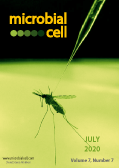Table of contents
Volume 7, Issue 7, pp. 162 - 201, July 2020
Cover: Anopheles gambiae mosquito being injected with hemolymph for malaria research study (image by the National Institute of Allergy and Infectious Diseases, National Institutes of Health (USA); the image was modified by MIC). The cover is published under the Creative Commons Attribution (CC BY) license.
Enlarge issue cover
Regulation of Cdc42 for polarized growth in budding yeast
Kristi E. Miller, Pil Jung Kang and Hay-Oak Park
Reviews |
page 175-189 | 10.15698/mic2020.07.722 | Full text | PDF |
Abstract
The Rho GTPase Cdc42 is a central regulator of cell polarity in diverse cell types. The activity of Cdc42 is dynamically controlled in time and space to enable distinct polarization events, which generally occur along a single axis in response to spatial cues. Our understanding of the mechanisms underlying Cdc42 polarization has benefited largely from studies of the budding yeast Saccharomyces cerevisiae, a genetically tractable model organism. In budding yeast, Cdc42 activation occurs in two temporal steps in the G1 phase of the cell cycle to establish a proper growth site. Here, we review findings in budding yeast that reveal an intricate crosstalk among polarity proteins for biphasic Cdc42 regulation. The first step of Cdc42 activation may determine the axis of cell polarity, while the second step ensures robust Cdc42 polarization for growth. Biphasic Cdc42 polarization is likely to ensure the proper timing of events including the assembly and recognition of spatial landmarks and stepwise assembly of a new ring of septins, cytoskeletal GTP-binding proteins, at the incipient bud site. Biphasic activation of GTPases has also been observed in mammalian cells, suggesting that biphasic activation could be a general mechanism for signal-responsive cell polarization. Cdc42 activity is necessary for polarity establishment during normal cell division and development, but its activity has also been implicated in the promotion of aging. We also discuss negative polarity signaling and emerging concepts of Cdc42 signaling in cellular aging.
Yeast-based assays for the functional characterization of cancer-associated variants of human DNA repair genes
Tiziana Cervelli, Samuele Lodovichi, Francesca Bellè and Alvaro Galli
Reviews |
page 162-174 | 10.15698/mic2020.07.721 | Full text | PDF |
Abstract
Technological advances are continuously revealing new genetic variants that are often difficult to interpret. As one of the most genetically tractable model organisms, yeast can have a central role in determining the consequences of human genetic variation. DNA repair gene mutations are associated with many types of cancers, therefore the evaluation of the functional impact of these mutations is crucial for risk assessment and for determining therapeutic strategies. Owing to the evolutionary conservation of DNA repair pathways between human cells and the yeast Saccharomyces cerevisiae, several functional assays have been developed. Here, we describe assays for variants of human genes belonging to the major DNA repair pathways divided in functional assays for human genes with yeast orthologues and human genes lacking a yeast orthologue. Human genes with orthologues can be studied by introducing the correspondent human mutations directly in the yeast gene or expressing the human gene carrying the mutations; while the only possible approach for human genes without a yeast orthologue is the heterologous expression. The common principle of these approaches is that the mutated gene determines a phenotypic alteration that can vary according to the gene studied and the domain of the protein. Here, we show how the versatility of yeast can help in classifying cancer-associated variants.
Histone H3E73Q and H4E53A mutations cause recombinogenic DNA damage
Pedro Ortega, Desiré García-Pichardo, Marta San Martin-Alonso, Ana G. Rondón, Belén Gómez-González and Andrés Aguilera
Research Articles |
page 190-198 | 10.15698/mic2020.07.723 | Full text | PDF |
Abstract
The stability and function of eukaryotic genomes is closely linked to histones and to chromatin structure. The state of the chromatin not only affects the probability of DNA to undergo damage but also DNA repair. DNA damage can result in genetic alterations and subsequent development of cancer and other genetic diseases. Here, we identified two mutations in conserved residues of histone H3 and histone H4 (H3E73Q and H4E53A) that increase recombinogenic DNA damage. Our results suggest that the accumulation of DNA damage in these histone mutants is largely independent on transcription and might arise as a consequence of problems occurring during DNA replication. This study uncovers the relevance of H3E73 and H4E53 residues in the protection of genome integrity.
Hiding in plain sight: vesicle-mediated export and transmission of prion-like proteins
Mehdi Kabani
Microreviews |
page 199-201 | 10.15698/mic2020.07.724 | Full text | PDF |
Abstract
Infectious proteins or prions are non-native conformations of proteins that are the causative agents of devastating neurodegenerative diseases in humans and heritable traits in filamentous fungi and yeasts. Prion proteins form highly ordered self-perpetuating fibrillar aggregates that traffic vertically and horizontally from cell to cell. The spreading of these infectious entities relies on different mechanisms, among which the extracellular vesicles (EV)-mediated traffic. The prion form of the yeast Saccharomyces cerevisiae Sup35p translation terminator causes the [PSI+] nonsense suppression phenotype. This fascinating biological model helped us shape our understanding of the mechanisms of formation, propagation and elimination of infectious protein aggregates. We discovered that Sup35p is exported via EV, both in its soluble and aggregated infectious states. We recently reported that high amounts of Sup35p prion particles are exported to the yeast periplasm via periplasmic vesicles (PV) in glucose-starved cells. EV and PV are different in terms of size and protein content, and their export is inversely regulated by glucose availability in the growth medium. We believe these are important observations that should make us revise our current view on the way yeast prions propagate. Hence, I propose several hypotheses as to the significance of these observations for the transmission of yeast prions. I also discuss how yeast could be used as a powerful tractable biological model to investigate the molecular mechanisms of vesicle-mediated export of pathological protein aggregates implicated in neurodegenerative diseases.










